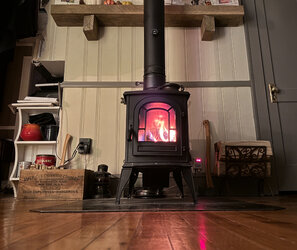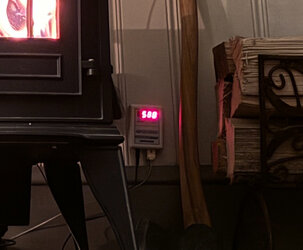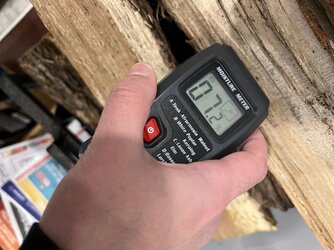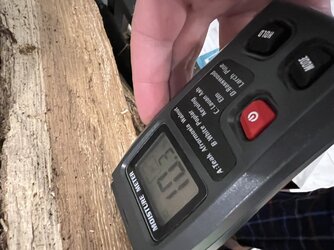Insufficient heat output
- Thread starter CTwoodinsert
- Start date
-
Active since 1995, Hearth.com is THE place on the internet for free information and advice about wood stoves, pellet stoves and other energy saving equipment.
We strive to provide opinions, articles, discussions and history related to Hearth Products and in a more general sense, energy issues.
We promote the EFFICIENT, RESPONSIBLE, CLEAN and SAFE use of all fuels, whether renewable or fossil.
You are using an out of date browser. It may not display this or other websites correctly.
You should upgrade or use an alternative browser.
You should upgrade or use an alternative browser.
Yes, what is stt?Magnetic thermometers are inherently inaccurate. Put that along with running around 100-200 degrees lower than what STT should be, you may not be getting the heat you want. In my stove, 200* STT variation makes a big difference.
EbS-P
Minister of Fire
Stove top temp.Yes, what is stt?
IR gun and digital flue temps. That’s how I run mine.
30WCF
Minister of Fire
Stove top temperature. Which is not the same as door temperature or stove pipe temperature or flue gas temperature. Best bet is a digital thermometer like an Auber in the pipe if you can get it. If you have an insert, I think they make a probe that you can get inside the flue collar or something. Others will know more about that. Mine is in the pipe reading internal gas temperature.
Im usually 500-650 with a good fire going. You can see I’m about 580 here inside the pipe.


Im usually 500-650 with a good fire going. You can see I’m about 580 here inside the pipe.


30WCF
Minister of Fire
Thanks I can see itI can’t seem to upload a clear pic right now.
I need to get oneStove top temp.
IR gun and digital flue temps. That’s how I run mine.
EbS-P
Minister of Fire
My 24' is way better with the damper I installed. Flue probe also helped manage air shut down better. I like to cruise 700-750 flue temps with 600-650 stt. Some guys with the same stove go to 850 stt but I don't. I hit that before the damper install, but not anymore.
Ditto the moisture content concerns with the oak. Surface moisture and cellular moisture are two different animals.
Ditto the moisture content concerns with the oak. Surface moisture and cellular moisture are two different animals.
Use the moisture meter correctly. Re-split a selection of splits that have been at room temp (indoors overnight minimum). Immediately test the freshly exposed inner face/surface. With the grain. Report what you find.
It more than likely will humble you on your having dry/seasoned wood thoughts.
You simply must confirm moisture content of what you're trying to get heat out of if you want to move past that nagging concern.
It more than likely will humble you on your having dry/seasoned wood thoughts.
You simply must confirm moisture content of what you're trying to get heat out of if you want to move past that nagging concern.
30WCF
Minister of Fire
Just to be sure… you are measuring a fresh split, at room temperature, probes inserted deeply, with the length of the grain?
As in, split a chunk, bring it inside for an hour or two and test it.
As in, split a chunk, bring it inside for an hour or two and test it.
I'm trying out a damper on our 20' flue this season. I haven't needed one in the past, but wanted to test it out in our stove so that I could better answer questions. This meant modifying a section of 6" DVL to add one.
Wouldn't you know it that this year we have the driest wood we've ever burned due to our long drought summer and dry November. Today's full load started out normal, but continued to gain momentum. I had the air fully closed and the flue temp kept climbing past 700º. I closed the flue damper fully and that stopped the climb at around 750º. In about an hour it was down to 650 and cruising nicely. The secondary show was particularly nice with this load.
Wouldn't you know it that this year we have the driest wood we've ever burned due to our long drought summer and dry November. Today's full load started out normal, but continued to gain momentum. I had the air fully closed and the flue temp kept climbing past 700º. I closed the flue damper fully and that stopped the climb at around 750º. In about an hour it was down to 650 and cruising nicely. The secondary show was particularly nice with this load.
30WCF
Minister of Fire
When did you start to open the damper back up? Did you go full open or step it up?I'm trying out a damper on our 20' flue this season. I haven't needed one in the past, but wanted to test it out in our stove so that I could better answer questions. This meant modifying a section of 6" DVL to add one.
Wouldn't you know it that this year we have the driest wood we've ever burned due to our long drought summer and dry November. Today's full load started out normal, but continued to gain momentum. I had the air fully closed and the flue temp kept climbing past 700º. I closed the flue damper fully and that stopped the climb at around 750º. In about an hour it was down to 650 and cruising nicely. The secondary show was particularly nice with this load.
30WCF
Minister of Fire
Sometimes I shut mine down, then start incremental adjustments to open it as it cools.
Use the moisture meter correctly. Re-split a selection of splits that have been at room temp (indoors overnight minimum). Immediately test the freshly exposed inner face/surface. With the grain. Report what you find.
It more than likely will humble you on your having dry/seasoned wood thoughts.
You simply must confirm moisture content of what you're trying to get heat out of if you want to move past that nagging concern
I keep the wood in a small rack near the insert. It shows under 10% humidity. So not sure seasoned wood is my problem. Obviously it would be better if I split it to small pieces to get more heat but I don’t really use too many big logs. Usually mix between small and slightly bigger pieces. Any chance it could be something else other than seasoned wood?
Last edited:
YesJust to be sure… you are measuring a fresh split, at room temperature, probes inserted deeply, with the length of the grain?
As in, split a chunk, bring it inside for an hour or two and test it.
EbS-P
Minister of Fire
I think we need some way to classify the vigor of the secondary air jets. I think that would be helpful in diagnosing overdraft by sight. Yours in the video are wispy and dancing. That’s what I like to see. When you get the blow torch look it’s moving to much air at some point. .
Yes I have good draft and I can see the secondary burnsI think we need some way to classify the vigor of the secondary air jets. I think that would be helpful in diagnosing overdraft by sight. Yours in the video are wispy and dancing. That’s what I like to see. When you get the blow torch look it’s moving to much air at some point. .
Ctwoodtick
Minister of Fire
If that’s the oak that you’re measuring at under 10%, something is not right. Are you splitting the wood and then testing in the fresh face of the split wood?I keep the wood in a small rack near the insert. It shows under 10% humidity. So not sure seasoned wood is my problem. Obviously it would be better if I split it to small pieces to get more heat but I don’t really use too many big logs. Usually mix between small and slightly bigger pieces. Any chance it could be something else other than seasoned wood?
In southern New England, 15% is about the ultimate lowest I can see.
Dieselhead
Minister of Fire
How’d you load a video is that YouTube?
It’s mixed with other type of wood redwood ie. Please see below imagesIf that’s the oak that you’re measuring at under 10%, something is not right. Are you splitting the wood and then testing in the fresh face of the split wood?
In southern New England, 15% is about the ultimate lowest I can see.
i didn’t start a fire today but when I do it tomorrow I will upload a videoHow’d you load a video is that YouTube?
Similar threads
- Replies
- 12
- Views
- 2K
- Replies
- 1
- Views
- 459
- Replies
- 12
- Views
- 1K



